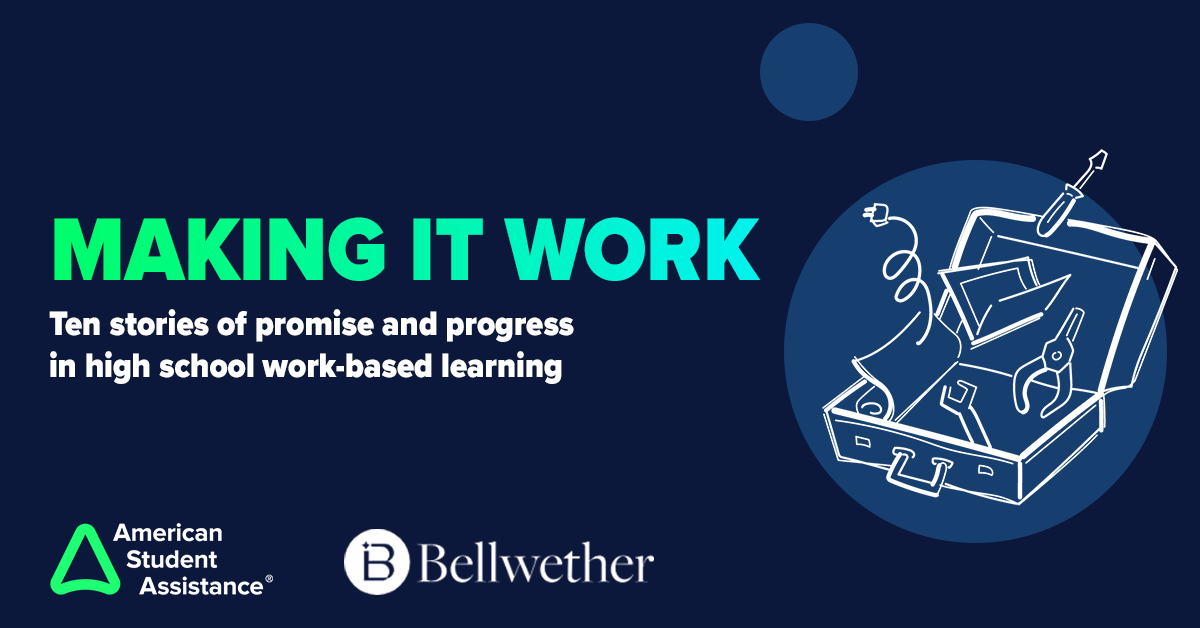During the recent ASA-moderated panel session at ASU+GSV Summit 2021, “Skills-Based Hiring: A Paradigm Shift for Educators,” which drew more than 480 attendees, participants discussed how the paradigm shift to skill-based hiring is changing the landscape for students, school districts and employers, how students are demonstrating skills, and how policymakers, business leaders and education leaders are leveraging technology to foster skill development and ensure equal opportunity for all.
Panelists included Skillsline Founder, Courtney Reilly; LinkedIn Learning N.A. Workforce Development & Higher Education System Lead, Jake Hirsch-Allen; and Credly VP of Business Development, Pete Janzow.
At ASA, we’re committed to helping kids understand their career identity, build workplace skills, and explore a full range of career options earlier in their education journey. We know that while the postsecondary path may not include a four-year degree, a non-college path can certainly be a great option for many students. That’s why we must empower students to make the postsecondary education choice based on their personal interests and career goals. We need to help students understand what those options are, so they can develop a plan. With that said, we also know that all options aren’t always on the table, as long as employers continue to include a bachelor’s degree as part of job requirements.
This panel discussion explored the importance of helping employers to transition away from hiring based solely on the minimum education level achieved and move instead toward hiring based on a specific set of skills. Our panel of experts also discussed how our education system can better prepare students not just for entrance into college, but for a good first job, whether the path to that job is through a traditional bachelor’s program or not. Below are key takeaways.
Employers need to rethink job requirements: We know that while there are millions of job openings according to the Department of Labor, millions of people are unemployed and looking for work. Employers have responded to the tight labor market in some cases by raising wages and offering bonuses. However, employers also need to rethink their hiring requirements to better align not only with the level of education job seekers has achieved, but also the level of skills they can exhibit to prove how successful they can be in completing job requirements. This not only takes a shift in thinking from employers, but also an establishment of infrastructure necessary to evaluate these skills, and an education system that ensures future employees have the necessary foundational skills to become workplace ready.
What innovative companies are doing to support the shift to skills-based hiring: Enter Skillsline, a relatively young new company, that provides a micro lesson platform to teach employability skills and also support social emotional learning for high school students. Founder Courtney believes it’s important that students are learning these necessary skills while they’re still in K12.
LinkedIn Learning’s Jake also commented on the challenges associated with hiring based on degrees and years of experience, which inhibits the access to opportunity that this country was built on. “These requirements can lead to the elimination of many qualified people, and we’ve seen data on our platform in terms of individuals that are progressing or not progressing through our labor force.” As a result, LinkedIn and other companies are beginning to think first about the skills that people need for a given job. The hypothesis is that hiring based on a skills approach will create a more equitable outcome. The ecosystem of higher education, workforce development, and employers all seem to be focusing on creating a more equitable economy and society based on skills instead of college degrees.
Credly is part of this ecosystem that is focused on hiring based on skills. Since 2012, the company has been involved in the landscape around verification of skills and standardization of communicating what those skills are in the form of digital credentials. Getting credential data into the hands of the people who are making decisions from a human capital perspective is very important. So, employers are tapping into the data around individuals’ credentials and skills.
States also are starting to recognize their role in creating sets of standards around employability skills and social emotional learning standards. Schools also need more funding in order to provide professional development training opportunities for teachers. Skillsline is working to help teachers to incorporate employability skills learning content without having to learn an entirely new curriculum. Also, the pandemic has made us realize that technology can play a role that is supplemented and deepened by teachers.
Shift away from time-based credit system: We also need to change the way we give credit to students in K12 and higher education, which is all time-based and tied to transcripts. We need to break that model in order to move towards this skill-based paradigm. One organization called Mastery Transcript Consortium (MTC) — a growing network of public and private schools committed to re-inventing how all students prepare for college, career, and life — is doing excellent work in their efforts to make this shift happen.
The role of technology in removing bias associated with degrees or years: Technology is being leveraged to hire specific individuals with certain skills and roles. For instance, to determine a skills path, an individual can visit LinkedIn and take a course and assessment. If the individual does well enough on the assessment, a given company automatically grants that person a screening with a recruiter, in order to continue the process. This removes the bias associated with degrees or years of experience. This allows us to get to a world in which we can test whether skills-based hiring results in more equitable outcomes and a better society.
Credly on helping employers to see the value in skills-based hiring: “We’ve seen companies like Microsoft and Google and IBM, and a number of others move away from the requirement of a college degree,” said Peter. They are considering skills an individual has and competencies that can be demonstrated. More and more schools are doing good work to help students gain hands-on experience and build skills through entrepreneurship experiences, career-focused challenges, and work-based learning opportunities. There are interview-based tech companies that are figuring out how to provide real time feedback to interviewers, in order to help them determine the most objective or unbiased way to evaluate prospects.
Empowering individuals to communicate their human skills: Some districts and states are creating rubrics from a student’s point of view, so that the student can identify where they are on a continuum. In this way, they will be able to better understand the skills they have, and how to communicate this information with employers.
Thank you for reading. We hope you found this helpful and we’d love to hear your thoughts.




